With grateful appreciation to Nippon Bijutsu Token Hozon Kyokai, The
Japanese Sword Museum 1-25-10, Yoyogi, Shibuyaku, Tokyo 151
Traditionally the Japanese sword has been a most important treasure of
the Japanese people. We should do what we can to preserve it in order to pay
respect to our ancestors who created such a great form of art. Swords must be
treated with utmost precaution so as not to injure the handler. Precautions to
protect them from scratches and rust are also necessary.
| Tools |
|---|
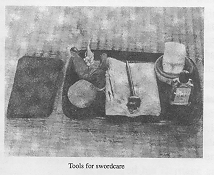 | - Mekugi-nuki: A tool to remove the bamboo peg (mekugi)
holding the blade in the hilt; usually made of brass or bamboo.
- Uchiko:
The most finely ground whetstone powder (30-35g) for cleaning the blade surface.
First, wrapped in Japanese hand-made paper called Yoshinogami, then rewrapped by
cotton or silk cloth, it comes through the wrapping materials when patted on the
blade surface.
- Nuguigami: High quality thick Japanese paper must be
thoroughly wrinkled to soften and remove coarse and dusty elements for wiping
the blade surface. There are two reasons for the wiping function; one for
preliminary removal of old oil and the other for removal of the powder. When
using flannel, the fabric must be washed, destarched in water, then dried.
-
Abura: A rust-preventive oil called choji or clove oil.
- Abura-nuguishi:
Paper used to spread oil over the blade surface. A piece of wiping paper or
flannel will do.
- Others: A wooden hammer and benzene, if
necessary.
|
| Method of Swordcare |
|---|
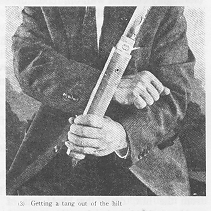 |
- Lay down the mounted blade and push the peg out
in preparation for removing the hilt.
- Pull the blade out of the
scabbard.
- To remove the hilt, hold its end with the left hand on the side
where the back of the blade is fit, and keep the blade in a slightly angled
upright position. Use the right fist to hit the left wrist lightly a few times.
When the tang (nakago) becomes slightly loosened in the hilt, repeat until the
tang comes out of the hilt by itself. When there is enough room to grasp the
tang, the blade may be pulled out of the hilt by the right hand. Be careful not
to hit the left wrist too hard with the right hand as there is a danger that
blades with short tangs like tanto might bounce out of the hilt entirely.
Therefore, the initial impact must be light, just to check how tightly the tang
is fixed in the hilt. Then, the force of subsequent blows must be adjusted
accordingly. When the blade is taken out of the hilt, the peg removed from the
hilt should be replaced.
- If the bIade is mounted in full koshirae, other
attachments such as swordguard (tsuba) and spacers (seppa) on both sides of the
swordguard in addition to the collar must be removed. When the collar is fit too
tightly to remove, it can be loosened by hitting it with a wooden hammer on the
back (mune) after covering the collar with a cloth for protection.
- The
wiping process requires two pieces of paper. The initial one removes the old oil
and dust, which is called preliminary cleaning. First place the cleaning paper
on the back and fold it into halves toward the edge. Then, hold the
paper-covered blade from above the back so that the thumb and the forefinger
grip each side of the cutting section from above the paper.
Hardly any force
is needed to wipe the blade upward, one way, starting from the base. When the
cleaning paper reaches the point, be particularly careful in wiping lightly. No
pressure or friction must be put on the point. When expertise is attained, the
wiping action can also be both ways, up and down. Lack of experience could cause
the cutting of paper or even fingers and thus it must be strictly avoided.
-
In case the oil cannot be removed with ease, cotton or gauze soaked in benzene
or pure alcohol may be used in the same wiping manner as described above.
|
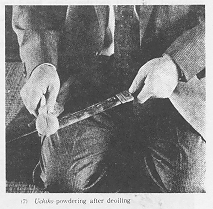 | -
The powdering starts from the base toward the tip on the obverse in a light,
uniform patting motion to cover the blade surface. Then turn the blade over and
start patting from the point downward toward the base.
|
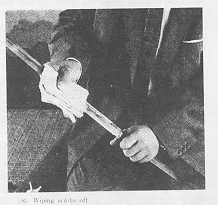 | -
Then, use the other
sheet of paper to wipe the powder off the blade surface in the same manner as
described in (5) in this section. If oil remains, some more powdering and wiping
is necessary.
|
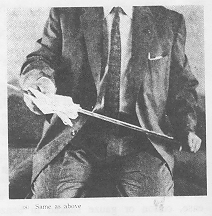 | -
When the surface is thoroughly clean, check for the presence
of rust, flaws and other damages. Then, without putting back the hilt, collar
and other attachments, the blade alone must be placed back in the
scabbard.
It should be noted that the two kinds of wiping paper used in this
process must not be interchanged and should have distinct purposespreliminary
and final.
- The re-oiling with a piece of paper, or destarched flannel,
folded in size 3cm x 6cm and soaked in fresh oil completes a round of swordcare.
When the paper is ready, the sword is to be drawn out of the scabbard again.
After placing it in the left hand, put the oiling paper on the back to do the
same movement as described in the wiping process.
To make sure the blade
surface is thoroughly covered with oil, repeat the same procedure a few times.
Just as in the wiping, the handling of the sword as well as the oiling paper
must be most carefully done. The paper should contain the right amount of oil so
that no excess oil will overflow and harm the scabbard. The oil mustbe spread
thinly and evenly.
- It is a good idea to apply oil to the surface of the
tang with one's fingers. However, an excessive amount of oil must also be
avoided here.
- Put the collar back and encase the blade tentatively in the
scabbard. Remove the peg from the hilt, draw the blade out of the scabbard, hold
it in the right hand in an almost upright position, pick up the hilt with the
other hand, and put the tang back in the hilt. Keep holding the blade in the
hilt with the left hand and hit the bottom of the hilt lightly with the palm of
the right hand so that the tang settles firmly in the hilt. When the tang is
fixed in its perfect position, replace the peg.
|
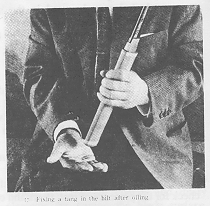
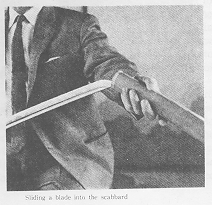 |
Then, pass the blade to the
right hand, pick up the scabbard and slide the blade into it observing the
manner described in Section II. Needless to say, the other parts like spacers
and swordguards of fully mounted swords must also be returned to their
respective places before the hilt is put on the tang.
- The methods for
handling and caring for other forms of blades such as spears (yari) and halberds
(naginata) are the same. Spears must be handled especially carefully; otherwise
injury may occur. Also, the daggers of double-edged type (ken) are very
dangerous.
Swordcare tools must be kept perfectly clean, for dust stuck on
the wiping cloth or oiling paper could cause scratches on the steel surface.
Protecting these surfaces which have been most finely polished through the
graded processes involving more than ten kinds of whetstones of different
fineness and hardness is critical.
|







